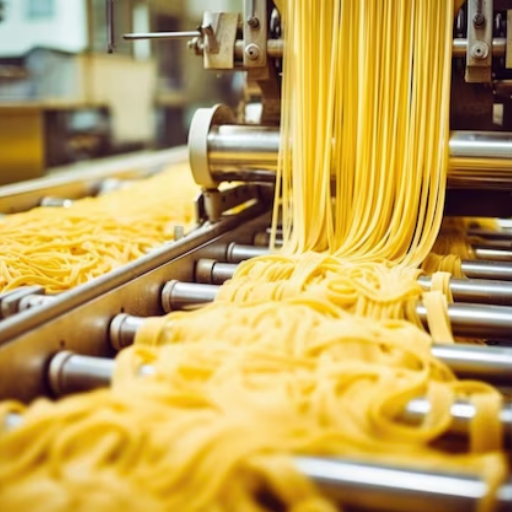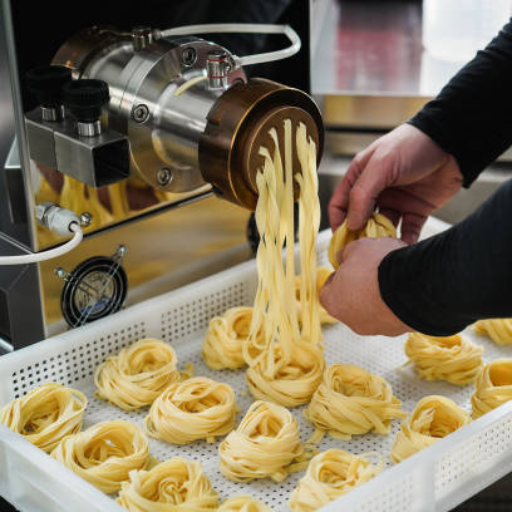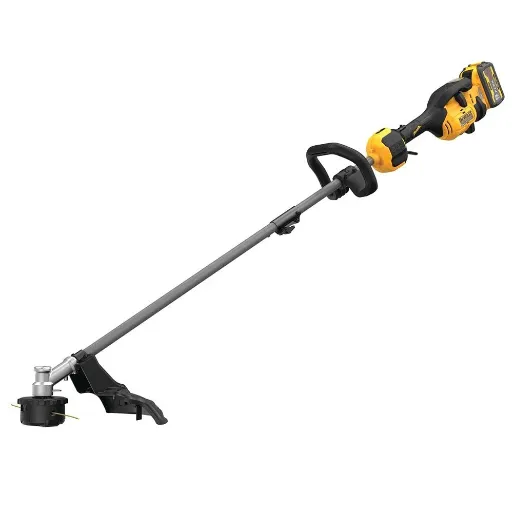Setting up a pasta plant, whether to produce fresh or dry materials, involves knowledge about complex technologies, equipment selection, and efficient organizational processes. Therefore, the purpose of this text is to expound in detail both the processes and important considerations that are needed when one wants to successfully launch a pasta mass production business. We will compare and contrast fresh and dried types of pasta production processes, highlight the apparatus needs, and discuss the supply chain and logistics systems necessary for efficient functioning. Also, the manual will elaborate on the issues relating to the management and control of quality as well as the sanitation of the production facility and the users will be guided on how to enhance the quantity and quality of the output. In consequence, consumers and readers of this blog will know in detail the guidelines for setting up and operating a pasta production line that is compliant with market expectations and operational standards.
What is a Pasta Production Line?

A system of interrelated parts designed for high volume output of fresh, or dried pasta is called pasta production line. Relevant operations include the mixing and kneading of the dough, shaping the pasta, and its final processes of drying and packaging. The equipment and processes used in fresh pasta production, for instance, differ from those used in the production of dried pasta in that they have to be shorter in time and special storage conditions have to be incorporated so that the pasta structure and taste can be retained. An efficiently configured pasta production process will provide consistency, high output, and quality which will fill the needs of both small economical artisan producers and mass industrial plants.
Understanding the Basics of Pasta Production Process
The process of producing pasta begins with selecting the right flour such as semolina or durum wheat flour which has good gluten properties suitable for making pasta flour. The major operations begin with mixing water with flour to form a dough which is kneaded to strengthen the gluten and generate elastic dough. Afterward, this particular dough has been either extruded or rolled up into specific forms according to the intended shape of the pasta in question.
In the production of fresh pasta, its or rather the dough is cut and shaped along with quick-drying methods being employed to keep the overall tenderness intact. It is sensitive and needs refrigeration to keep its freshness and quality intact. Alternatively, dry pasta follows a drying mechanism in which moisture content is low, therefore its shelf life is high and no cooling is required.
Maintaining the quality of food items is extremely critical during the entire procedure – powdered and liquid forms should have the same properties and tastes, while surface and volume shapes should be identical. Sampling for moisture, strength, and elasticity values and external feature shapes and sizes are performed routinely. Sanitation and hygiene protocols are observed to mitigate contamination and protect food.
Achieving these basics enables the producers to provide the required outputs from a pasta production line that meets consumer and market requirements for quality and preferences respectively.
Key Components of a Pasta Line
A line for pasta manufacture usually incorporates several basic machineries, in particular, the mixers that combine different ingredients to form a plastic dough. After that, in the process, extruders come, attaching their importance by forming the plastic mass into assorted shapes of pasta with versatility. Next come the Cutters or the rollers, who operate later in the making process and help to bring the required shape & size to the pasta. Dryers are important especially in the making of dry pasta as they eliminate moisture to prolong the life of the product. Also, quality control instruments are nuisance variables in the analysis as they assess parameters like moisture content, and texture among others. Each of the components plays a pivotal role in ensuring the different stages of processes are integrated effectively, and a high-quality range of past products are made more efficiently.
Differences Between Fresh Pasta Production Lines and Dry Pasta Lines
The difference between fresh pasta production lines and dry pasta lines is mainly in the methods of processing, the equipment utilized, and the end product. Due to high volume orders and demand, fresh pasta production lines aim to maintain the necessary abundance of water to ensure softness and shorten the time the production takes. Some of these include maintaining 70%-80% humidity, and the use of low drying temperatures in the ranges of 30°C- 50°C. However, most fresh pasta lines tend to operate on machines that enable cutting and shaping the paste with minimal or no extensive drying processes.
On the other hand, a target in the case of the lines for dry pasta is to remove so much moisture in the product that it enhances its durability and storage abilities. Therefore, such a production line applies high temperatures – 80°C to 110°C – for long periods to reduce the moisture level below 12%. The mission of dry pasta machines is to manufacture more of the pasta with fewer ‘working’ time intervals in between. Apart from the obvious, the substantial differences in parameters and techniques make it envisaged that every line, feature, and quality conform to the end product and customer expectations.
How to Choose the Right Pasta Machine

To select the appropriate pasta machine, it is important to assess numerous factors that will determine whether or not it meets the requirements of your production process. First, distinguish between whether you will be processing fresh pasta or dry pasta since there are different processing requirements for the two. For fresh pasta, an emphasis on gentle kneading, cutting accuracy, and the ability to operate with high humidity and low temperatures is a must. The machines should also be safe to use on tender dough and not damage the dough. For dry pasta, however, use equipment with strong drying features, high temperature, and long processing periods to reduce moisture content. Moreover, take into account the volume of production and make sure that the capacities of the machine match with the volumes cold be required. Last but not least, smooth functioning and reliability require looking into the maintenance of the machine, its simplicity in operation, and customer assistance which are very important for the viability of the operations.
Evaluating Pasta-Making Machine Options
Assessing options for machine-made pasta requires defining what the actual production aims are. The main factors are – the type of macaroni you want – dry or fresh – and how much you plan to produce. State-of-the-art equipment for fresh pasta production is very much concerned with the integrity of the dough through the processes of mixing and cutting. On the other hand, Dry pasta machines operate at elevated temperatures and are meant for extended periods of drying.
Another key parameter stems from the integration of the machine into the automated production line with minimal manual usage. According to the information presented on the website, a large number of manufacturers provide machines equipped with a changeable setting for different types of pasta.
Last, but not least, take into consideration the productivity and reliability of the appliances for they will determine the profitability in the operation stage. All these benefits besides the price, warranty terms, and support should be considered when investing in the machinery. Given such considerations, a machine that systematically meets your requirements for macaroni production can be picked.
Understanding Machinery Needs for Production Capacity
First, the later explains that it is important to start with estimating the volume of pasta production that my business would need and then focus on the machinery needs for the production capacity. It may be the case that I would need a machine that consumes more volume or a more flexible one for smaller capacity jobs; either way, hence I will require the appropriate machine. Apart from that, what I have found is that it is also important to take into account the different kinds of pasta that my setup has, as there are machines that focus on producing either fresh or dry pasta and are designed with different features. The technology integrated into these machines, such as automation capabilities is of course very important. There is a good chance that this can reduce manual involvement directly and improve at the same time overall efficiency. Further, I got familiar with the conception that autonomously assessing the adaptability to different shapes of pasta is also important since it would allow for wider product range. In the end, however, the cost-to-efficacy ratio of the machine should also be pointed out since in such machinery it is important to look for reliability, extended warranty, and weak customer support.
The Role of Automation in Pasta Production Line
Among the numerous advantages of automation in the pasta manufacturing process is its ability to improve the production process in terms of both efficacy and accuracy. Through automation, You will be able to cut back on the amount of manual labor performed, which will in turn lower the likelihood of mistakes, and make production speedier. It makes sense to view parameters such as machine throughput measured kilograms of pasta per hour which this parameter shows the maximum amount of pasta that can be easily made into the required form. Automation will be able to conform to different shapes and sizes of pasta tubes and easily replaceable molds’ configuration will determine maximum cycle time, which in turn determines the shapes and number of shapes that can be produced. Also pay attention to energy consumption, and attributes of the implemented technologies for integration in the existing systems, as it impacts the cost of the operations. As the consumers of the vast majority of automatic systems are professionals and do not require special training it is easy to calibrate and supervise them which in turn leads to soaring labour productivity. In a word, automation does not only respond to but even most of the time surpasses the current levels of production requirements which makes automation a cornerstone in the marketing spheres of most modern food companies.
What are the Raw Material Requirements?

The quality and uniformity of the pasta product can only be sustained by choosing the right raw materials. The main component is wheat flour, more specifically, durum wheat semolina which contains the necessary gluten content for the type of pasta required. The water helps hold the particles together and also assists in making the dough. To enrich or flavor any pasta other ingredients such as eggs, spinach, tomato, or squid ink can be used. The quality of all the raw materials has to be of appropriate standard in compliance with regulations and the materials have to be obtained from reputable sources. Also, considering the effective shelf life, such materials should be stored under a category that will prevent contamination and maintain quality. To achieve a satisfactory end product that meets the requirements and preferences of the consumers, the manufacturers need to assess these specifications adequately.
Importance of Flour and Semolina
Pasta or macaroni is a wholesome food product and flour and semolina are indispensable for its mass production. Both ingredients bear a significant influence in defining the structure, the nutritional value as well as the quality of the macaroni products. Over other types of wheat, pasta makers prefer semolina derived from the desirable durum, which contains high protein levels essential to the tough ‘al dente’ style structural characteristic of quality pasta. The flour is high in protein, therefore, it means good quality pasta retains its shape during cooking without becoming too soft and easily disintegrating. The grains of semolina are even able to increase the adhesion of the paste to the sauce, making the taste more pleasant. A proper ratio of semolina and flour enables pasta products to satisfy even the most demanding customers and achieve high quality and great taste in every meal.
Sourcing and Quality of Raw Material
It is possible to state that the kind of wheat used for macaroni should be semolina due to its high protein content and gluten, which can provide strength and elasticity to pasta. It is equally important that wheat used should be obtained from reliable sources who follow standard operating procedures of quality control. Balanced wheat import proportions as well as appropriate consumption ensure the necessary uniformity in texture, taste, and other characteristics of the dishes. Additionally, with the increase in concerns about global climate change, ethical and sustainable practices are more and more paramount to companies so they can align with their consumers. With emphasis on these areas, I look forward to making pasta that is of exceptional taste and nutrition as well as leading sustainable farming practices.
What are the Types of Pasta Produced?

Pasta is an all-inclusive food that comes in different forms and sizes. Though we may think there are many types of sauces or dishes to complement pasta, the reverse is true; there are several types of pasta that can be briefly described outlining their particular purpose. Long and thin pasta best for use with light sauces or simple dishes with a base of tomatoes is called spaghetti. Diagonal cut tubes of pasta, otherwise known as penne form possess well-defined edges and are ideal for mashing and anchoring thick sauces. Flat and thick fettuccine is native to rich and creamy sauces like Alfredo. Playful in its shape, bowtie pasta, or farfalle enhances dishes with its subtle depiction making it suitable for salads and light sauces. Also, baked dishes can include layers of such sheets, while orzo which is shaped like rice is great for thick soups as well. All the varieties of pasta have been developed to be served in a particular way that showcases the brilliant versatility and dynamic range of the culinary arts.
Understanding Different Types of Pasta
To understand the characteristic features of the different types of pasta and satisfactorily respond to the above questions, it is important to address some specific characteristics that describe each category. Here’s a table:
Spaghetti: Spaghetti is best served with light tomato sauces because its diameter ranges from 1.8 to 2.2 mm making it a slender and round shape perfectly suited to such mild flavors.
Penne: Penne is well-suited for chunky meats that are about 50 to 75 millimeters in length and 6 to 8 millimeters in diameter with a tube-like cylindrical form and angled tops.
Fettuccine: This pasta type is similar in width at around 6.5 to 10 millimeters but unlike the other pasta sections the texture is thick and flat which is ideal for a creamy wrap of Alfredo sauce or mushroom sauce.
Farfalle: Farfalle has a playful shape measuring about 3.8cm by 1.2cm and is best used in salads or noodles where its light sauce is representative of a floudered mixture.
Lasagna Sheets: Typically wider sheets that are around 3 by 9 inches. Their respective form is preferably used in baked dishes whereby the sheets are layered and would have to be parboiled or fresh to cook them well.
Orzo: orzo is a pasta shaped like a grain of rice, measuring about 1 cm in length and ideal for soups and broth since it absorbs taste from the cooking liquid and possesses the ability to take on the shape of the broth.
Such technical parameters assist in selecting the appropriate pasta type for particular gastronomic purposes and allow the dishes to obtain the appropriate ‘bite’ and balance in the mixture of flavors.
Special Considerations for Filled Pasta
Pastries such as ravioli or tortellini need to be scrutinized regarding their stuffing since it affects the sauce range as well as the presentation of the dish. For me, a light touch with a sauce like plain sage butter or some light stock works well because the fillings are not overpowered such as cheese meat, or even vegetable fillings. Further, the next thing to consider is the thickness of the pasta dough; it must be thick enough to contain the filling but not so thick that the piece will be cooked unevenly. It is also important to use the best pasta since it will provide better taste and even texture than the boxed alternative which is why using fresh pasta is recommended as it improves the dish.
Production of Short Pasta and Long Pasta
The technology of pasta production of both types begins with a strict selection of the grain – durum wheat. This is followed by the mixing of the flour with water so that a dough can be prepared and kneaded to the right consistency. In the case of short pasta, the dough is passed through the holes of varying shapes and sizes of penne or fusilli die, then cut off. In contrast, long pasta such as spaghetti or linguine is manufactured through a high-output extrusion process that creates strands. Both varieties of pasta are subjected to drying under specified conditions to achieve specific moisture content which preserves the pasta on the shelves and makes it suitable for cooking. The current technology has incorporated standardized and automated procedures in the pasta-making industry, but the experience of craft pasta production in which texture and flavor come first is still prevalent. Technique and Equipment differ and therefore greatly influence the quality of the end product making the entire process a science and an art.
References
- Italiana Food Tech – Commercial Pasta Equipment
- ITALGI – Machines for Industrial Pasta Factories
- Storci – How to set up a pasta factory
Frequently Asked Questions (FAQ)
Q: What is the role of a pasta press in a pasta production line?
A: A pasta press is a crucial component in the pasta processing line, used for shaping dough into various types of fresh pasta. It is designed to handle different components of the dough, ensuring uniformity and consistency in the pasta shapes produced.
Q: How do I select the appropriate machine for the production of fresh pasta?
A: When selecting a machine for the production of fresh pasta, consider the production needs of the customer, such as the desired output in kg per hour, the types of fresh pasta required, and whether a fully automatic line is preferred. Contact us for tailored advice on pasta machinery for industry.
Q: What are the different components involved in a complete line for pasta production?
A: A complete line for pasta production typically includes a pasta extruder, a pasta press, drying equipment like a continuous dryer, conveyors, and pre-drying units. Each component plays a specific role in ensuring efficient and high-quality production of both fresh and dry pasta.
Q: How does a continuous dryer function in the production of dry pasta?
A: A continuous dryer is used in the production of dry pasta to gradually reduce the moisture content of the pasta through controlled temperature and humidity settings. This ensures the pasta is dried evenly and efficiently, ready for packaging and long-term storage.
Q: Can the line handle both short-cut pasta and long-cut pasta?
A: Yes, the line is designed to handle both short-cut pasta and long-cut pasta. With the appropriate settings and attachments, the pasta machinery can switch between different pasta shapes and sizes to meet diverse production requirements.
Q: What materials are used in the construction of pasta processing lines?
A: Pasta processing lines are typically constructed from stainless steel, which ensures durability, hygiene, and ease of cleaning. This material is ideal for maintaining the quality standards required in industrial production.
Q: How do temperature and humidity affect the production of pasta?
A: Temperature and humidity are critical factors in both the production of fresh and dry pasta. Proper control ensures the dough’s consistency during shaping and prevents spoilage during drying. Industrial pasta machinery is equipped to maintain optimal conditions throughout the production process.
Q: What types of fresh pasta can be produced with a pasta extruder?
A: A pasta extruder can produce various types of fresh pasta, including fresh laminated pasta and other custom shapes. By changing the dies, you can create different pasta shapes to suit market demands.









